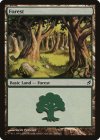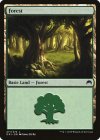Chris Taylor
Contributor
It's a great feeling having all your A list cloths back in the game


Noticed this while sorting Forests. Two different artists, eight years appart. Is this homage? Inspiration? Some policy of making new art for core sets? I'm very intrigued.
View attachment 7857View attachment 7858
On scryfall:
Steve Prescott's Lorwyn Forest: https://scryfall.com/card/lrw/300/forest
Jonas De Ro's Origins Forest: https://scryfall.com/card/ori/271/forest
I would guess this was done on purpose because part of Magic Origins took place on Lorwyn, but a lot of Lorwyn-style art doesn't fit with the rest of the set. It looks like they re-painted a location on Lorwyn with an updated style.o_O Those are suspiciously similar, down to the trees in the background...
Ooh, it must be that, although it feels weird to want to refer Lorwyn forests but not wanting to use the actual art but redraws in a different style. I checked after your suggestion and from the Forests of Origins two seem to be redraws of Lorwyn forests and the other two are the original art from two Zendikar forests. The other basic lands are either reused art from the planes appearing in the expansion that had been visited or new art for those that had not. The redraw has been only done on these two forests.I would guess this was done on purpose because part of Magic Origins took place on Lorwyn, but a lot of Lorwyn-style art doesn't fit with the rest of the set. It looks like they re-painted a location on Lorwyn with an updated style.
To be fair you don't use this site very often.Aw... I missed the spam?!
WOTC products are trash, buy superior MPC productsWith Hasbro's and WotC's greed about to infect D&D (see this, e.g., for a short explanation) I might hold my wallet closed for a while regarding WotC products...
Paizo’s pulling the trigger on their “own” OGL variant! It’s going to be perpetual and irrevocable, and it’s not going to be owned by a publisher but by an independent law firm (to be transferred to a yet to be founded neutral foundation at a later date)! Link. They’ve also gone and said Pathfinder 2e doesn’t actually need the OGL, and the only reason it’s mentioned is to enable third parties to create stuff that adds to PF2e. So, now that WotC decided to be a greedy cow, Paizo is going rogue!
Okay, hot take, maybe, but D&D being such a big name, even if it isn't perhaps the best system out there, has been a boon for the RPG hobby. It's always been a rather niche hobby, and it's only because D&D has become so popular that you can easily find other players to play with. In "old" times, before the OGL existed, the TTRPG community was fractured and small, each RPG having its own tiny, shrinking island of players, and it was damn hard to make a living in the industry. The OGL and ensuing ubiquitousness of D&D has given many, many people a solid foundation to build on, and it has grown the TTRPG hobby considerably. I belief this is a good thing.This would be exciting if the OGL wasn't just a legal stunt to encourage people to make derivative works instead of competing with D&D directly.
OK, that's not the original intent of the license, but that's how WotC has been more-or-less using it.
(Long story short: game rules aren't subject to copyright in the US, and even if they were (and you had to avoid WotC's rules), it's actually shockingly easy to create a new RPG — I have a friend who once wrote one in a single evening, while heavily drunk. The OGL is just WotC offering you the ability to use D&D's prestige in exchange for shackling yourself to their IP and giving them a share of your profits.)
